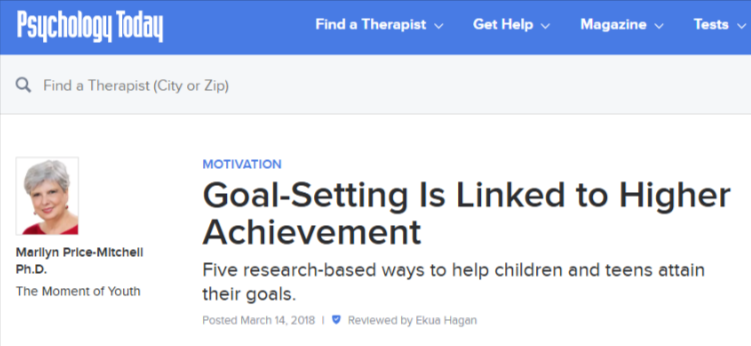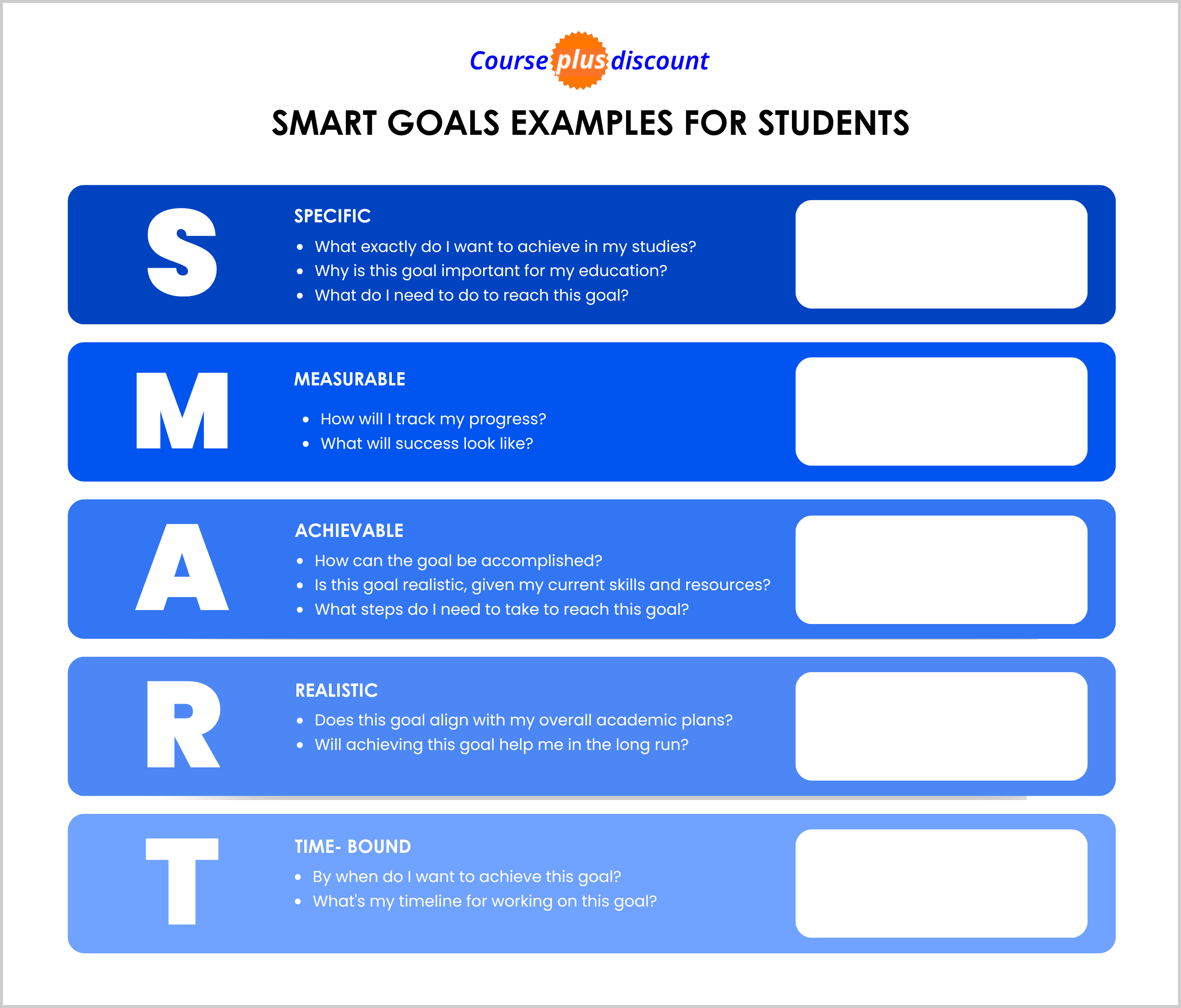Feeling overwhelmed by assignments, extracurriculars, and personal commitments? You’re not alone. As a student, the SMART goals framework (Specific, Measurable, Achievable, Relevant, Time-bound) offers a research-backed approach to transform vague aspirations into achievable outcomes.
Studies by Psychology Today show that students using structured goal-setting are more likely to achieve their objectives compared to those with undefined goals.
In this guide, I will walk you through creating practical SMART goals tailored explicitly for academic success, with practical templates, examples, and strategies to implement immediately in your student life.
So, without further ado, let us get right into it!
What Are SMART Goals?
The SMART acronym stands for Specific, Measurable, Achievable, Relevant, and Time-bound.

According to a study published in the Journal of Psychology Today, individuals who use structured goal-setting methods like the SMART criteria are more likely to achieve their objectives than those who set vague goals.

Understanding The SMART Criteria For Goals
Let’s break down what each letter in the SMART method goals represents:
S – Specific
Your goal should be clearly defined your goal. Rather than “I want better grades,” try “I want to improve my Biology grade from a B- to a B+ this semester.”

M – Measurable
How will you track progress? Include concrete numbers or indicators to know when you’ve reached your goal. For example, “I will complete 25 practice problems each week.”

A – Achievable
While your goal should challenge you, it must remain realistic, given your current circumstances. Consider your available time, resources, and abilities.

R – Relevant
Ensure your goal aligns with your broader academic or career aspirations. Ask yourself: “Does this goal help me progress toward my long-term objectives?”

T – Time-bound
Set a clear deadline to create urgency and prevent procrastination. For instance, “by the end of this semester” or “within six weeks.”

SMART Goals Template For Students
Ready to create your own SMART goals? Use this template to structure your objectives. If you are unsure what some words mean, read the article below. I have given the breakdown of each concept after the template:
Goal Statement: Write down your goal in one sentence. Then answer each of the questions given below:

Academic SMART Goals: Setting Yourself Up For Success
Academic goals are often the primary focus for students. These are your “Goal Statement.” Here are some example academic SMART goals you might adopt:
Freshman In High School
“I will improve my study habits by completing homework immediately after school for at least 30 minutes each day, resulting in turning in 100% of assignments on time this quarter.”
Senior In High School
“I will complete college applications for my top five schools by November 1st by working on them for 3 hours each weekend, starting September 1st.”
College Freshman
“I will adapt to college-level coursework by utilizing the campus writing center at least once per paper and attending professors’ office hours bi-weekly, resulting in maintaining at least a 3.0 GPA my first semester.”
College Senior
“I will complete my senior thesis by breaking it into six milestones with specific completion dates, dedicating 10 hours weekly to research and writing, and submitting a final draft two weeks before the deadline for feedback.”
SMART Goals Examples For Students
Here are some practical SMART goals examples relevant to both high school and college students to help you apply this framework to your own life.
Let us begin with an example for high school students:
Example 1: Improving GPA
- Specific: Raise my overall GPA from 3.2 to 3.5
- Measurable: Track grades on each assignment and test.
- Achievable: Focus mainly on improving Math and Science grades by 10%.
- Relevant: A higher GPA will strengthen college applications.
- Time-bound: By the end of this semester.
Example 2: Time Management
- Specific: Develop a consistent study schedule.
- Measurable: Study for 45 minutes each day, 5 days per week.
- Achievable: Use 15-minute breaks between study sessions.
- Relevant: Consistent studying prevents cramming and reduces stress.
- Time-bound: Establish this routine within two weeks and maintain it for the semester.
Now, moving on to SMART goals examples for college students:
Example 1: Course Completion
- Specific: Complete all assignments for Organic Chemistry with a B+ or higher.
- Measurable: Submit every assignment on time and score at least 85% on each.
- Achievable: Attend weekly tutoring sessions and form a study group.
- Relevant: This course is essential for my pre-med requirements.
- Time-bound: By the end of this semester.
Example 2: Research Opportunity
- Specific: Secure a research assistant position in the Psychology department.
- Measurable: Apply to at least 5 research labs and prepare for interviews.
- Achievable: Update resume, attend office hours with professors, and complete relevant coursework.
- Relevant: Research experience strengthens grad school applications.
- Time-bound: By the end of this academic year.
How to Apply the SMART Method Goals in Real Life
Here is how I apply the SMART method goals in real life. However, to help students, I am taking the situations that are more related to you:
Initial Goal Example:
“I want to do better in math.”
SMART Version:
“I will raise my Algebra II grade from a C to a B+ by the end of this semester by completing 30 minutes of extra practice problems daily, attending after-school tutoring twice weekly, and forming a study group that meets every Sunday afternoon.”
How to Implement the SMART Plan:
Step 1: Set up a dedicated study space and a consistent time for daily practice.

Step 2: Schedule tutoring sessions in advance and set reminders.
Step 3: Form a small study group with peers to meet weekly.

Step 4: Track quiz and test scores to measure improvement.
Step 5: Celebrate small wins (e.g., higher quiz scores) to stay motivated.
Change tactics if progress halts, but keep pursuing the goal. This structured approach enables students to move forward consistently and effectively to enhance their academic performance.
Why SMART Goal Objectives Work For Students
Here are 6 reasons why SMART Goal Objectives work effectively for students:
- SMART goals give clear targets, guiding students in their achievements.
- Deadlines help students stay organized and minimize stress.
- Measurable goals enable tracking of progress and strategy adjustments.
- By focusing on objectives, SMART goals limit distractions and highlight priorities.
- Realistic goals enhance motivation, fostering a sense of achievement.
- Regularly reviewing these goals encourages growth and self-improvement.
Common Challenges and Solutions When Setting SMART Targets
Here are the likely challenges students like you face with their solutions:
- Challenge 1: Taking on too many goals at once
Solution: To begin with, focus on just 2–3 key SMART goals. Master the process first, then scale up gradually without overwhelming yourself.
- Challenge 2: Setting overly ambitious targets
Solution: Aim high, but stay grounded. Choose goals that challenge your limits without setting you up for burnout. Self-awareness is your best guide.
- Challenge 3: Losing motivation over time
Solution: Break big goals into smaller milestones and reward yourself along the way. Visible progress feels more real and exciting.
- Challenge 4: Failing to adapt when things change
Solution: Review and revise your goals monthly. Life changes—your goals can, too. Flexibility keeps you moving forward without frustration.
Read Next:
Conclusion: Your SMART Journey Begins Now
The SMART goals framework transforms vague student ambitions into concrete achievement plans. By incorporating specific, measurable, achievable, relevant, and time-bound elements, you create a roadmap to academic success rather than merely hoping for it.
Research shows that setting structured goals greatly enhances results. Whether you’re aiming to boost your GPA, manage time better, or prepare for your career, the SMART method provides the structure needed to turn aspirations into accomplishments.
Start today by converting one academic challenge into a SMART goal using our template, and experience the difference that purposeful planning makes in your student journey.
FAQs
The 5 SMART goals in education focus on academic performance, time management, skill development, extracurricular engagement, and career preparation.
Here is an example of a SMART goal for student behavior: “I will reduce classroom disruptions by raising my hand before speaking 100% of the time for the next month, tracked by my teacher.”
A SMART goal for a student is specific, measurable, achievable, relevant, and time-bound, like “I’ll complete all calculus homework with 90% accuracy this quarter.”
Examples include improving a specific course grade by semester end, reading 30 minutes daily, completing a thesis by April, or mastering 50 vocabulary words in two weeks.
